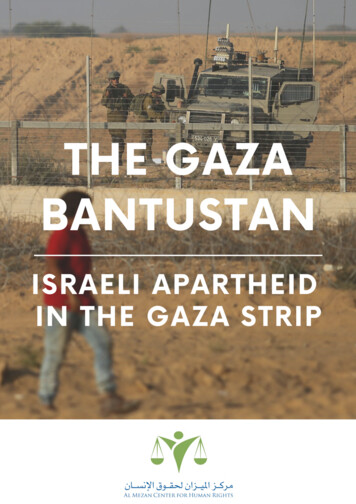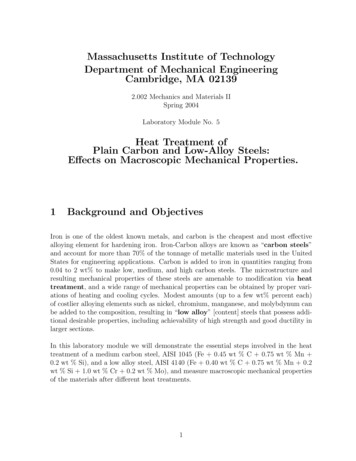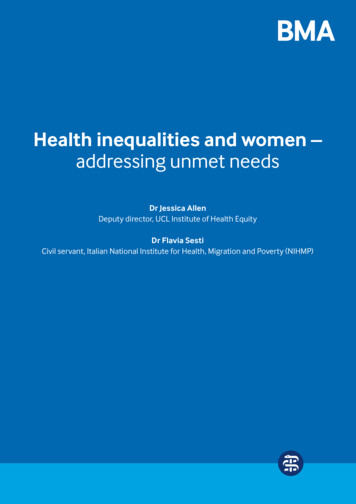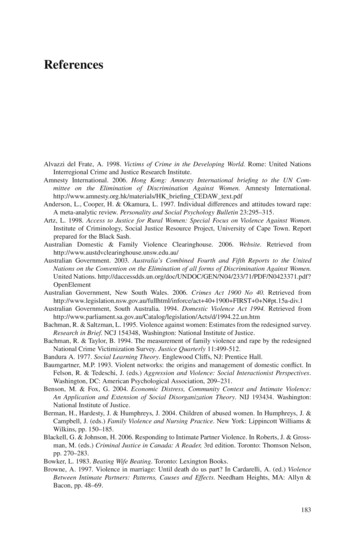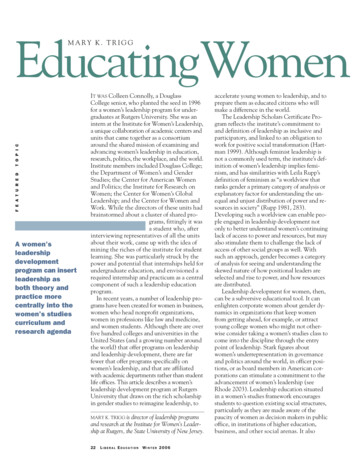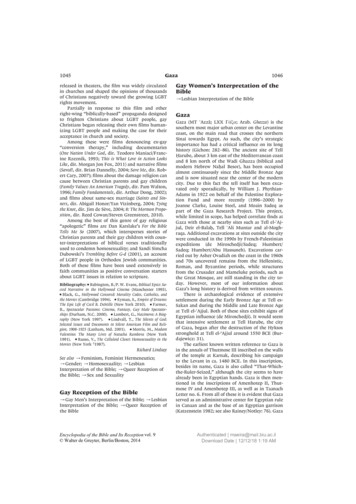
Transcription
Gaza1045released in theaters, the film was widely circulatedin churches and shaped the opinions of thousandsof Christians negatively toward the growing LGBTrights movement.Partially in response to this film and otherright-wing “biblically-based” propaganda designedto frighten Christians about LGBT people, gayChristians began releasing their own films humanizing LGBT people and making the case for theiracceptance in church and society.Among these were films denouncing ex-gay“conversion therapy,” including documentaries(One Nation Under God, dir. Teodoro Maniaci/Francine Rzeznik, 1993; This is What Love in Action LooksLike, dir. Morgan Jon Fox, 2011) and narrative films(Saved!, dir. Brian Dannelly, 2004; Save Me, dir. Robert Cary, 2007); films about the damage religion cancause between Christian parents and gay children(Family Values: An American Tragedy, dir. Pam Walton,1996; Family Fundamentals, dir. Arthur Dong, 2002);and films about same-sex marriage (Saints and Sinners, dir. Abigail Honor/Yan Vizinberg, 2004; Tyingthe Knot, dir. Jim de Sève, 2004; 8: The Mormon Proposition, dir. Reed Cowan/Steven Greenstreet, 2010).Among the best of this genre of gay religious“apologetic” films are Dan Karslake’s For the BibleTells Me So (2007), which intersperses stories ofChristian parents and their gay children with counter-interpretations of biblical verses traditionallyused to condemn homosexuality; and Sandi SimchaDubowski’s Trembling Before G-d (2001), an accountof LGBT people in Orthodox Jewish communities.Both of these films have been used extensively infaith communities as positive conversation startersabout LGBT issues in relation to scripture.Bibliography: Babington, B./P. W. Evans, Biblical Epics: Sacred Narrative in the Hollywood Cinema (Manchester 1993). Black, G., Hollywood Censored: Morality Codes, Catholics, andthe Movies (Cambridge 1994). Eyman, S., Empire of Dreams:The Epic Life of Cecil B. DeMille (New York 2010). Farmer,B., Spectacular Passions: Cinema, Fantasy, Gay Male Spectatorships (Durham, N.C. 2000). Lambert, G., Nazimova: A Biography (New York 1997). Lindvall, T., The Silents of God:Selected Issues and Documents in Silent American Film and Religion, 1908–1925 (Lanham, Md. 2001). Morris, M., MadamValentino: The Many Lives of Natacha Rambova (New York1991). Russo, V., The Celluloid Closet: Homosexuality in theMovies (New York 21987).Richard LindsaySee also /Feminism, Feminist Hermeneutics;/Gender; /Homosexuality; /LesbianInterpretation of the Bible; /Queer Reception ofthe Bible; /Sex and SexualityGay Reception of the Bible/Gay Men’s Interpretation of the Bible; /LesbianInterpretation of the Bible; /Queer Reception ofthe BibleEncyclopedia of the Bible and Its Reception vol. 9 Walter de Gruyter, Berlin/Boston, 20141046Gay Women’s Interpretation of theBible/Lesbian Interpretation of the BibleGazaGaza (MT Azzâ; LXX Γ ζα; Arab. Ghazza) is thesouthern most major urban center on the Levantinecoast, on the main road that crosses the northernSinai towards Egypt. As such, the city’s strategicimportance has had a critical influence on its longhistory (Gichon: 282–86). The ancient site of TellH arube, about 3 km east of the Mediterranean coastand 8 km north of the Wadi Ghazza (biblical andmodern Hebrew Naḥal Besor), has been occupiedalmost continuously since the Middle Bronze Ageand is now situated near the center of the moderncity. Due to this fact the tell itself has been excavated only sporadically, by William J. PhythianAdams in 1922 on behalf of the Palestine Exploration Fund and more recently (1996–2000) byJoanne Clarke, Louise Steel, and Moain Sadeq aspart of the Gaza Research Project. This project,while limited in scope, has helped correlate finds atGaza with those at nearby sites such as Tell el- Ajjul, Deir el-Balaḥ, Tell Ali Muntar and al-Moghraqa. Additional excavations at sites outside the citywere conducted in the 1990s by French-Palestinianexpeditions (de Miroschedji/Sadeq; Humbert/Sadeq; Humbert/Abu Hassuneh). Excavations carried out by Asher Ovadiah on the coast in the 1960sand 70s uncovered remains from the Hellenistic,Roman, and Byzantine periods, while structuresfrom the Crusader and Mameluke periods, such asthe Great Mosque, are still standing in the city today. However, most of our information aboutGaza’s long history is derived from written sources.There is archaeological evidence of extensivesettlement during the Early Bronze Age at Tell esSakan and during the Middle and Late Bronze Ageat Tell el- Ajjul. Both of these sites exhibit signs ofEgyptian influence (de Miroschedji). It would seemthat intensive settlement at Tell Harube, the cityof Gaza, began after the destruction of the Hyksosstronghold at Tell el-‘Ajjul around 1550 BCE (Burdajewicz: 31).The earliest known written reference to Gaza isin the annals of Thutmose III inscribed on the wallsof the temple at Karnak, describing his campaignto the Levant in ca. 1480 BCE. In this inscription,besides its name, Gaza is also called “That-Whichthe-Ruler-Seized,” although the city seems to havealready been in Egyptian hands. Gaza is then mentioned in the inscriptions of Amenhotep II, Thutmose IV and Amenhotep III, as well as in TaanachLetter no. 6. From all of these it is evident that Gazaserved as an administrative center for Egyptian rulein Canaan and as the base of an Egyptian garrison(Katzenstein 1982; see also Rainey/Notley: 76). GazaAuthenticated maeira@mail.biu.ac.ilDownload Date 12/12/18 1:19 AM
1047Gazaalso appears in several of the Amarna letters; it ismentioned three times in EA no. 289, emphasizingits importance as an administrative center, perhapseven as the “capital” of all Egyptian-ruled Canaan.In fact, some scholars believe that “The (city of) Canaan” mentioned in 13th-century BCE sources suchas the reliefs of Seti I and Papyrus Anastasi I referto Gaza, although this is debated (for which see Hasel). Katzenstein believes that the “Canaan” thatprecedes Ashkelon, Gezer, Yeno‘am and Israel onthe late 13th century stele of Merneptah also refersto the city, although most scholars (such as Rainey/Notley: 99; Hasel: 11–12) assert that the referenceis to the province. Papyrus Anastasi III, from aboutthe same time, names four Egyptian officials whoreside at Gaza, although one has a Semitic nameand two have Semitic patronyms (Katzenstein 1982:112–13). The final New Kingdom mention of Gazais in the “Onomasticon of Amenope” from sometime in the 12th century. This Egyptian “encyclopedia” lists the three coastal cities of Ashkelon, Ashdod and Gaza, and then several of the so-called “SeaPeoples”, the Shardan, the Sikel and the Philistines,who had come to dominate the area. This would bea new phase in the history of Gaza.Our knowledge of the history of Gaza in theearly parts of the Iron Age comes mostly from theBible. According to Gen 10 : 19, Gaza marked thesouth-western boundary of the Canaanites, whichmatches its position as the south-westernmost major city in Canaan. In fact, if indeed “the Brook ofEgypt” mentioned in that position in Num 34 : 5,Josh 15 : 4 and related texts is indeed the Naḥal Besor/Wadi Ghazza as suggested by Nadav Na aman,rather than the traditional Wadi el- Arish, thiswould seem to indicate that these texts reflect along-lasting geopolitical reality (for discussion seeLevin 2006: 56–58).Deuteronomy 2 : 23 mentions the “Avvites, whodwelt in villages as far as Gaza” being replaced by“Caphtorim who came from Caphtor”. The Avvitesare also mentioned as living south of the Philistinerealm in Josh 13 : 3–4. As “Caphtor” is often takento be a name for Crete, it is often assumed that thereference is to the area of Gaza being invaded bythe so-called “Sea Peoples”, of which the Philistineswere one.There is no biblical story according to whichGaza was ever conquered by the invading Israelites.According to Josh 11 : 21–22, Joshua expelled the“Anakim” from the hill-country, leaving them onlyin Gaza, Gath, and Ashdod. Ekron, Ashdod, andGaza, with their “dependencies and villages” thatbordered on “the Brook of Egypt” are listed in asort of appendix to the Judahite town-list in Josh15 : 45–47, apparently excluding them from the territory of Judah. The statement in Judg 1 : 18 according to which Judah captured Gaza, Ashkelon, andEkron is “corrected” by the LXX version, whichEncyclopedia of the Bible and Its Reception vol. 9 Walter de Gruyter, Berlin/Boston, 20141048states that Judah did not capture them. And Josh13 : 3 lists “the Gazite” as one of the “five sĕrānîmof the Philistines.” From its context it is clear thatthese sĕrānîm were rulers of some sort – varioustranslations render “lords,” “captains,” “chiefs”and the like. In modern scholarship it is commonlyassumed that the word seren is related to the Luwian tarwanis and the later Greek τ ραννος – bothtitles for city-rulers (Zukerman). From this pointonward, Gaza consistently appears as one of whatmodern scholars often refer to as “the PhilistinePentapolis,” featuring in many of the stories of theongoing struggle between the Philistines and Israel.Best known of these is Judg 16, which begins withSamson laying with a prostitute in the city and thentearing down its gates, and ends with his imprisonment in the city and his death in the ruins of thetemple of Dagon. Gaza also seems to be mentionedas the boundary of Midianite occupation in Judg6 : 4, although many scholars see this as referring toa town in the central hills rather than coastal Gaza(see Demsky). The Philistine Gazites are said to havecontributed golden hives and mice to the Ark whenit was returned to Israel (1 Sam 6 : 16–17), althoughthe Ark was not said to have actually been at Gaza.It may also be assumed that the Philistines of Gazawere included in the unified force that gathered tofight against Saul in 1 Sam 29 : 1–2, although specific cities are not mentioned. And while David isrecorded as fighting the Philistines several times(such as in 2 Sam 5 : 17–25; 8 : 1; 21 : 15–22; 23 : 9–23), all of these battles seem to have occurred farther north and east, on the Judah-Philistine frontier. In any case, Gaza is not mentioned in any ofthese accounts.Gaza is mentioned as being the southwesternborder of Solomon’s dominion in 1 Kgs 4 : 24 (MT5 : 4). It is usually assumed that Gaza, together withthe other main Philistine cities, was not actually annexed by David, but rather became a dependency ofsome sort. With the division and subsequent weakening of the Israelite kingdom, Gaza and other suchstates regained their independence. It is often assumed that toponym no. 11 in the list of conquestsof Sheshonq I (the Shishak who, according to 1 Kgs14 : 25–26, plundered Jerusalem) from Karnak isGaza, although in fact only the first sign is readable(Aharoni: 325; Aḥituv: 98; Kitchen: 435). This doesmake sense, considering Gaza’s position on themain road from Egypt and its former importance tothe Egyptians, but it is not the only reading possible. Gaza is then not mentioned in the Bible or inany other source until the 8th-century prophetAmos (1 : 6–7) who prophesizes the city’s destruction “because they carried into exile entire communities, to hand them over to Edom” – the historicalbackground of this prophecy is unknown.Since there is so little evidence from Gaza itself,our understanding of its position within the Philis-Authenticated maeira@mail.biu.ac.ilDownload Date 12/12/18 1:19 AM
1049Gazatine realm is largely dependent on the evidence uncovered at the other, better excavated Philistine cities of Ashdod, Ashkelon, Ekron and Gath, as wellas evidence from outlying sites such as Tell Qasile,correlated with Egyptian and biblical written references to the Philistines in general. From such documents as the inscriptions of Ramses III and theGreat Harris Papyrus, it would seem that the Prst(presumably equal to the Philistines) were one ofseveral groups that migrated from the general areaof the Aegean Sea during the early 12th centuryBCE, following the collapse of the Late Bronze AgeMycenaean culture. Despite Ramses’ claims to have“settled them in his land” they apparently tookover the pre-existing Canaanite cities of Gaza, Ashkelon, Ashdod, Gath, and Ekron, although it is impossible to know the exact process. Archaeologicalinvestigation of the latter four has shown the appearance of such “Aegean” cultural signs as locallyproduced Mycenaean-type pottery, hearths, culticobjects, and evidence of heightened pig consumption. At first these were limited to the immediatearea of the five cities, but they soon began to spreadover a wider area, evidence of the Philistines’ acculturation and of their becoming the dominant groupin the area. During Iron Age I and IIa, the Philistinecities were the largest in the country and Philistinesociety was apparently the most complex. A closereading of the biblical narrative shows that the Philistines played a critical role in the rise of Israeliteidentity and then statehood (for a recent summarysee Shai 2011).There is a certain measure of debate about thePhilistines’ internal political organization. Withinthe Bible, the five sĕrānîm are often seen as operating in tandem. On the other hand, Achish of Gathis referred to as “king.” This has lead some scholarsto assume that the five Philistine cities were aunited entity, led at first perhaps by Gaza or Ashdod and then by Gath, while others assume thateach city was a sovereign state, in the tradition ofboth Canaan and the Aegean world, and that theyunited ad hoc in times of danger (for a summary seeShai 2006).The earliest Assyrian document to mention thePhilistines is Adad-Nirari III’s Kalah Slab, from thelate 9th century BCE. In it, the Assyrian king listedtribute that he received from the land of Tyre-Sidon(the Phoenicians), the land of Bit-H̊umri (“House ofOmri”, Israel), the land of Edom and kur Palaŝtu,“the land of the Philistines” (Tadmor: 149). Thismay or may not indicate political unity among thePhilistines, but later Assyrian sources treat the Philistine cities as individual entities. Gaza and itsking H̊anno were captured by Tiglath-pileser III in734, and H̊anno, after being allowed to return tohis position, later also rebelled against Sargon IIand was taken off to Assyria in chains. According toSargon’s annals, he established a ka̲rum (port) onEncyclopedia of the Bible and Its Reception vol. 9 Walter de Gruyter, Berlin/Boston, 20141050the coast near Gaza. Mariusz Burdajewicz (36) hassuggested that this ka̲rum be identified with the recently-excavated site at Blakhiyah, north of themodern city. During Hezekiah’s rebellion againstSennacherib, S il-Bel of Gaza remained loyal to theAssyrians. This may be the background to 2 Kgs18 : 8 claiming that Hezekiah “smote the Philistinesas far as Gaza and its territory, from watchtowerto fortified town.” In any case Gaza seems to haveprospered as an Assyrian-dominated buffer state between Assyria and Egypt.After the death of Ashurbanipal in ca. 627, Assyrian hegemony over the Levant was replaced bythat of Egypt’s Psammetichus (Psamtik I), still supposedly an Assyrian vassal or ally. Both Diodorus(1.67.3) and Herodotus (2.157) tell of this Pharaoh’scampaigning in Philistia. H. Jakob Katzenstein(1994: 36) attributes the harsh prophecy of Zeph2 : 4–5 against Gaza, Ashkelon, Ashdod and Ekron,listed from south to north, to these events, assuming that the Philistine cities and their kings becamevassals of Egypt. He also considers the inscriptionmentioning “the King’s messenger to the Canaan(and) to Philistia, pa-di-Eset son of Apy” as referringto an Egyptian envoy to Gaza from this time. ThisEgyptian rule continued in the first years of NechoII’s reign, until, in the summer of 605, Nebuchadnezzar of Babylon captured “all the land that hadbelonged to the king of Egypt, from the Brook ofEgypt to the River Euphrates” (2 Kgs 24 : 7), bringing Gaza and the rest of Philistia under his rule.This is probably reflected in Jer 25 : 20 as well. Inthe following years, Nebuchadnezzar campaignedto Philistia several times. In 604 he destroyed Ashkelon. One line of his chronicle mentions an additional city, conquered in 603, but the name of thecity is partially missing. Anson F. Rainey and R.Steven Notley (262–63) suggest reading “Gaza”, although Katzenstein (1994: 43) disagrees. Althoughthe exact process is unclear, it is obvious that sometime in the following decade and a half, Gaza lostits status as a vassal kingdom and came to be ruleddirectly by Babylon. The Murashu archives fromNippur in Babylonia mention a settlement of Gazans called H̊azatu (“Gaza” – Zadok: 61). Gaza itselfbecame a Babylonian stronghold on the Egyptianfrontier, until it passed, together with the entireNeo-Babylonian Empire, into the hands of Cyrus II(the Great) of Persia in 539 BCE.In the summer of 525, Cambyses II, son of Cyrus, crossed the deserts of northern Sinai and conquered Egypt. According to Herodotus (3.4–9), heemployed the aid of “the king of the Arabs”, wholed his troops safely through the wilderness andsupplied them with water. He specifically describesthe road to Egypt as passing by “Kaditis” (Gaza), “acity that seems to me to be no smaller than Sardis”,commenting that from the border of that city as faras Ienysus, the seaports (Gk. µπορ α) belong to theAuthenticated maeira@mail.biu.ac.ilDownload Date 12/12/18 1:19 AM
1051GazaArabs. Later in his book, Herodotus (3.91) tells usthat in the days of Darius I, the territory of the Arabs was outside the “Fifth Satrapy” and was exemptfrom tax. Katzenstein (1989: 71) understood this asmeaning that the territory beyond Gaza was exempt from tax; Rainey (59) understood that Gazawas a part of the Arab area; Yigal Levin (2007: 248–49) has suggested that Gaza and the adjacent coastwere given to the Arab kingdom of Qedar, to serveas a terminus for the trade routes that lead fromArabia and from the Dead Sea to the Mediterranean. As such, Gaza was not part of the “Fifth Satrapy” and was probably ruled by a Qedarite governor. And while Herodotus’ comment comparingthe city with Sardis seems to show that the city wasprosperous, and it must have played a role in theongoing struggle between Persia and its rebelliousEgyptian vassals, it is not mentioned in any of oursources for the remainder of the Persian Period.Only the so-called “Philisto-Arabian” coins, whichmay have been minted at Gaza and have been foundall over the southern part of the land, testify to thecity’s economic status at this time (Mildenberg:95–96).When Alexander arrived in the area in 332 BCE,Gaza was ruled by Batis or Betis (Arrian 2.24.4 callshim a eunuch; see also Curtius 4.6.7; Josephus, Ant.9.320), either a Qedarite or a Persian. The city resisted and was only captured after a two-monthsiege, during which Alexander was wounded. Whenthe city did fall, Batis was executed by beingdragged by his heals from a chariot, the inhabitantswere killed or sold off, and the city was repopulatedby local tribesmen who were loyal to Alexander. Atthis point it was reorganized as a Greek-style π λις.Following Alexander’s death in 323 BCE, Gazachanged hands between his “successors”, the diadochi Ptolemy son of Lagos, Antigonus Monophthalmos and his son Demetrius. Between 312 and 301the city was apparently controlled by the Nabateans, who succeeded the Qedarites as in their control of the Arabian trade-routes, after which Gaza,together with much of the Levant, came under ruleof Ptolemaic Egypt. The Ptolemies would rule Gazafor just over a century, until the Fifth Syrian Warof 200–198 BCE, during which the entire countrywas taken over by the Seleucid Antiochus III. Thisperiod was one of prosperity, as can be seen fromnumismatic finds and from mention of the city inthe reports of the Ptolemaic tax-collecter Zenon,who toured the area in 259–258 BCE (Kasher: 68–70).We have no specific knowledge of events inGaza until about 150 BCE, at which time Jonathanthe Hasmonean besieged and plundered the city aspart of the power struggle between his patron Demetrius II and Tryphon (1 Macc 11 : 60–62; Josephus, Ant. 12.5.5). Gaza was later conquered by Alexander Jannaeus in about 96 BCE as a part of hisEncyclopedia of the Bible and Its Reception vol. 9 Walter de Gruyter, Berlin/Boston, 20141052ongoing war with the Nabateans, becoming a partof the Hasmonean kingdom. The city’s autonomyand status as a π λις was restored by the Romangeneral Pompey in 63 BCE, coming under thenewly-created province of Syria, until its inclusionin the kingdom of Herod the Great (40–4 BCE), although it was briefly under control of his enemyCleopatra VII of Egypt. After Herod’s death the cityreturned to the province of Syria. At some point a“new town” of Maiumas was constructed south ofthe old one, although it is difficult to know whichsources refer to this settlement and which to theolder city. Josephus claims that both were destroyedby the Jewish rebels during the Great Revolt, butthis destruction was short-lived, and Vespasiantransferred the once-again flourishing city to theprovince of Judea after the revolt. The emperorHadrian visited the city in 129–30 CE, an eventcommemorated on the city’s coins. Gaza is thenmentioned as one of the places at which Jewishrebels were sold into slavery at the end of the BarKokhba revolt in 135 CE (Kasher: 74–75). Two10th-century Karaite Jewish sources claim that during the years after the Bar-Kokhba revolt, Jewswould make pilgrimages to Gaza as a substitute forJerusalem, to which they were forbidden to travel(Huberman: 338). During the late Roman Period,Gaza became famous for its schools of rhetoric andfor its festivals, especially those held in the templeof Marnas (Belayche).Little is known of the first Christians of Gaza.It has been suggested that the earliest communitythere was lead by Philemon, to whom Paul’s NTepistle of that name is addressed (Glucker: 43). According to the available sources, several early Christians were martyred in or near Gaza. Despite this,a bishop of Gaza attended the Council of Nicaea in325, and the inhabitants of coastal Maiumas seemto have converted en masse, while the old Gaza remained mostly pagan, and the two populationsstruggled for domination of the city and its portuntil about 402 when the bishop Porphyry forciblyexpelled the pagan population and destroyed theirtemples (Glucker: 46–47). By this time, Gaza hadalso become a major center of Christian monasticism, beginning with Hilarion, a native of thenearby village of Thavatha, who founded the firstmonastery in the area in the mid-4th century. Thismonastery was destroyed by the pagan mobs duringthe brief rule of the anti-Christian emperor Julian“the Apostate” (361–63). However, monastic communities soon became one of the central components of the population of Gaza and the surrounding areas (Hirschfeld; Di Segni).During the Byzantine Period, Gaza-Maiumasbecame a prosperous city, known for its vineyardsand wine production, with its port serving as themain terminus of the Arabian/Nabatean spiceroutes (Mayerson; Glucker: 86–98). The school ofAuthenticated maeira@mail.biu.ac.ilDownload Date 12/12/18 1:19 AM
1053Gazarhetoric prospered under such orators as Ptolemaeus (who is honored in an inscription found atEleusis), Aeneas, author of the dialogue Theophrastus, Timotheus and, more than any other, Procopius, who served as chair of rhetoric at Gaza underEmperor Anastasius (491–518; Glucker: 51–54). Inthe 4th century, Maiumas Neapolis was renamed“Constantia”, in honor of the emperor Constantine.There was also a Jewish community in Gazaduring this period. In 1965, a partially-preservedmosaic floor was excavated by Egyptian archaeologists just south of the modern port, presumablypart of Maiumas, and was briefly reported as achurch floor showing a female saint playing a lyre,with Hebrew and Greek inscriptions (Leclant: 135).After the 1967 war, A. Ovadiah of the Israel Department of Antiquities and Museums excavated thesite, discovering the remains of a large, colorful synagogue mosaic, depicting a lyre-player who is identified by the Hebrew name “David,” dressed as aByzantine emperor in the guise of Orpheus, surrounded by a lion, a giraffe, and a snake listeningto his music (see fig. 20). Additional panels show abear, an antelope and other animals, and the wholeis surrounded by floral and geometric designs. AGreek inscription names the donors, Manamos andIasu (Menahem and Yeshua), as well as the date,508/9 CE (Ovadiah). In the 1970s the mosaics wereremoved to the nearby Israeli settlement of Netzarim for safekeeping, and in 1986 they were transferred to Jerusalem. The animal panels and inscriptions, as well as a replica of the David figure, arenow displayed at the Inn of the Good SamaritanMuseum near the Jerusalem-Jericho road (Magen:106). Another sign of Jewish presence in Gaza is theengravings of a menorah, a shofar and a lulav onstones that were later re-used in building the GreatMosque of Gaza. These were visible until the Intifada (Palestinian uprising) of the 1980s, at whichtime they were vandalized (Huberman: 338). Ovadiah assumes that the synagogue was destroyed during either the Persian invasion of 614 or the Arabconquest of 634. At the battle of Datin, near Gaza,the Byzantine commander Sergius was ambushedby the Arab ‘Amr ibn al-‘As, losing 4,000 men, ofwhich 2,000 were Jews (Gichon: 299; Huberman:342). However the city itself fell only in 637, thegarrison there executed after refusing to convert toIslam. The city itself, however, continued to prosper, and papyri from Nessana show that Greekspeaking Christians continued to live there for several decades (Glucker: 58–59). Gaza was later fortified and became a crucial link in a chain of fortresses that at first protected the Umayyad realmagainst the Byzantines, the Fatimids against theCrusaders, then the Crusaders against the Ayyubids. In 1170 Salah ad-Din (Saladin) failed to takeGaza from the Crusaders, succeeding only after thebattle of Hattin in 1187. Gaza fell to the MongolsEncyclopedia of the Bible and Its Reception vol. 9 Walter de Gruyter, Berlin/Boston, 20141054Fig. 20 “David playing the lyre” (6th cent. CE)in 1260 and again in 1290, and under the Mamluksthe city became the capital of the entire coastal area.At this time there were Christian, Jewish, and Samaritan communities in the city, each with its ownquarter (Huberman: 345). Gaza retained this position under the Ottoman Turks who took over thecountry in 1516 after a battle near Tell Jammah andon the Wadi Ghazza estuary (Gichon: 299–304).The Jewish community of Gaza, bolstered by Jewswho had recently been expelled from Spain andPortugal, became one of the largest in the HolyLand and included several prominent leaders, including the poet-rabbi Israel Najara (1555–1625).Gaza was also the home of Nathan Benjamin benElisha ha-Levi Ghazzati or Nathan of Gaza, a Jerusalem-born kabbalist and self proclaimed prophet,who became a major supporter of Shabbetai Zevi(Huberman: 358–61). In February of 1799 the citywas taken by Napoleon Bonaparte, who then retreated in May of that year.From 1831 to 1841 the Gaza area was controlledby the rebels Muhammad Ali and Ibrahim Pasha,until the Turkish government managed to reassertits hegemony over the region. This renewed controlwas brief, because on 9 November 1917, after managing to hold the city in face of overwhelming British force for nine months, the Turkish troops leftGaza, beginning a new era in the history of the cityAuthenticated maeira@mail.biu.ac.ilDownload Date 12/12/18 1:19 AM
1055Gaza(Gichon: 304–12). Gaza became a district capital under the British Mandate. The city’s Muslims andChristians who had fled the fighting returned immediately; the Jews, who had been evacuated by theTurks, were slower to return. By 1927 there wereabout fifty Jews in the city. These were once againevacuated, this time by the British police, when riots broke out against many of the Jewish communities in the summer of 1929. Jewish shops and a hotel were burned to the ground, and a permanentJewish presence in the city came to an end (Huberman: 370–75).When the British Mandate ended on 15 May1948, Egyptian troops invaded the Gaza region aspart of the Arab nations’ war against the State ofIsrael, which had been declared the previous day.The one Jewish village in the area, Kfar Darom, wascaptured by Egyptian forces. Under the February1949 Armistice Agreement, Gaza and a strip of territory along the coast remained under Egyptiancontrol. This territory became known as the GazaStrip. From 1948 until 1959, the Strip was officiallygoverned by the fictitious “All Palestine Government,” but was in fact under Egyptian military administration, except for the period from late October 1956 to March 1957, during which the Stripwas held by Israel following the Sinai Campaign. In1959 the Strip was put under direct Egyptian military government. During this period of Egyptiancontrol, the population of the city and the Strip increased dramatically due to the influx of 200,000–250,000 refugees from what had become Israel.Many of these were placed in refugee camps andput under the responsibility of the United NationsRelief and Works Agency for Palestine Refugees(UNRWA). Living standards decreased, and theStrip became a staging ground for fedayeen attacksagainst Israel. During the Six-Day War of June 1967the Strip was re-occupied by Israel and put underIsrael military administration. Beginning with there-establishment of Kfar Darom in 1970, twentyone Israeli settlements were constructed in the GazaStrip, eventually coming under the collective nameof “Gush Katif”.On December 8, 1987, what became known asthe first Intifada, or uprising against Israeli rule,broke out in the Jabaliyah refugee camp. In May1994, the Palestinian National Authority assumedcontrol of Gaza City and most of the Strip, excluding Israeli settlements and military zones (Bulle/Marmiroli). Following the second (“El-Aksa”) Intifada that broke out in Septemb
"apologetic" films are Dan Karslake's For the Bible Tells Me So (2007), which intersperses stories of Christian parents and their gay children with coun-ter-interpretations of biblical verses traditionally used to condemn homosexuality; and Sandi Simcha Dubowski's Trembling Before G-d (2001), an account of LGBT people in Orthodox Jewish .
